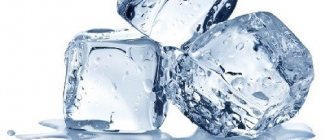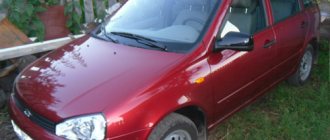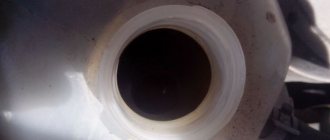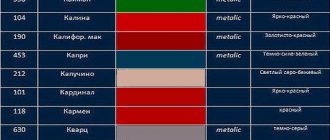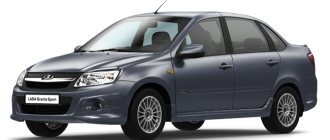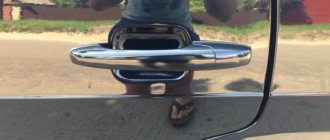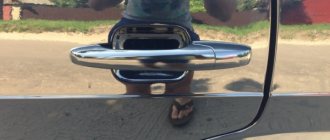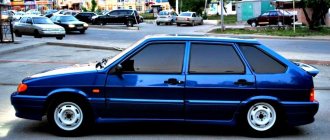VAZ 211440 is an improved version of the VAZ 2114, which, in turn, was released as a restyling of the “nine”. VAZ 211440 features of the model. The car was constantly refined by the manufacturer in order to optimize its technical characteristics and make it more comfortable to use. Two modifications were released, code 211440-24 (2009) and 211440-26 (2010).
VAZ 211440
The history of the creation of the VAZ-2114 car
The first VAZ-2114 appeared in 2001, and mass production began in 2003 and continued until 2013. The main manufacturer of the car is the Volzhsky Automobile Plant.
VAZ-2114 belongs to the family of small class passenger cars. Its restyled model VAZ-2109, produced since 1984, was a continuation of the family of front-wheel drive cars. The car, successful in its layout, transmission and engine, became the first AvtoVAZ line not related to technical borrowing from the FIAT-124.
The interior of the VAZ-2114 was equipped with a new instrument panel (the so-called “European panel”), a height-adjustable steering column, a steering wheel from the VAZ-2110, central door locking, an upgraded heater, and front electric windows.
On the territory of the USSR, the car was given the name “Sputnik” and only on export cars the name “Lada Samara” was used. After the collapse of the USSR, the Russian Federation decided to officially call the entire line of front-wheel drive cars “Lada Samara”.
History of creation
The 60s of the twentieth century were the golden time of the USSR. The country recovered from the most difficult war, science and industry developed at an unprecedented pace, and the standard of living of the population grew. In 1973, the oil crisis broke out, thanks to which a flow of currency poured into the Union, which had a beneficial effect on all areas of production, including the automobile industry. The VAZ automobile plant, built in Togliatti, produced cars of the Zhiguli family that were quite good for their time. But by the end of the 70s, the base model, Fiat-124, was morally outdated and did not meet the requirements of the time, so the country needed a modern car.
In 1979, AvtoVAZ engineers developed a prototype of the first car of a whole family, which would later be called “Samara” and become one of the legends of the USSR. This car was the legendary “Eight” (What does an eight car look like), followed by the “Nine” (all about the VAZ 2109 car), which surpassed its predecessor and became a symbol of success for the inhabitants of the country of the Soviets. But the golden time of the USSR was over, and the country was rapidly rushing into the abyss, to its collapse and collapse. The resulting destructive processes hit the automotive industry, causing a decline in production.
The Gamma platform, on which both cars were built, turned out to be surprisingly successful. The front and rear suspensions, without any special changes, moved from one family to another, and even the modern Lada Vesta is equipped with them. Therefore, the obsolescence of the Samara-1 family was associated with:
- exterior;
- interior;
- motors;
- electrical equipment.
By the mid-90s, when the country was flooded with a stream of cheap foreign cars from foreign car scrapyards, the popularity of the Samara-1 family began to decline. They could not compete on equal terms with much better equipped foreign models. The “Dashing Nineties” put an end to any full-fledged developments: the plant’s engineers focused on what could be fixed with minimal effort.
The first to appear were injection power units, built on the basis of the well-proven VAZ 21083 engine. The transition to fuel injection added a little power and also reduced exhaust toxicity. The latter was especially important, because cars with such engines were planned to be delivered abroad, where there were strict environmental standards.
Motor VAZ 21083
Then new instrument panels appeared (Panel VAZ 2108-2115) and richer electrical equipment, including air conditioners and front windows. However, this did not solve the problem of outdated appearance, so the VAZ-2109 was restyled, aka “Lada Samara-1” or Lada Samara in the five-door hatchback body turned into the VAZ-2114, or hatchback of the “Lada Samara-2” family. It was still the same good old “Nine”, but freed from the most significant shortcomings, so it looked good even against the background of modern budget foreign cars.
SPECIFICATIONS
POWER UNIT
Over the 10 years of serial production of the Lada 2114, several power units were placed under its hood. First, it is worth mentioning the 1.5-liter, 8-valve engine, which developed 78 horsepower and 116 Nm. This engine consumed about 7.3 liters for every 100 kilometers in combined mode.
This modification has an injection intake controlled via an electronic unit, replacing the obsolete carburetor intake. Not without a new camshaft with adjusted phases. After AvtoVAZ introduced an injector into the VAZ-2114 engine, a group of engineers increased the efficiency of the engine, adding power to it. On the other hand, it was also possible to reduce the “fuel appetite”.
In 2004, a modification of the power unit was released, with a displacement of 1.6 liters. The engine already produced 81 horsepower and 125 Nm. In combined mode, the engine consumed 7.6 liters per hundred kilometers. The eight-valve injection power plant has an increased volume thanks to the cylinder height increased by 2.3 millimeters, which provided a longer piston stroke.
Instead of the ignition module, they began to install a coil. The new version of the engine has become more powerful and environmentally friendly, but gasoline consumption has increased when compared with the first 1.5-liter engine. In addition, in the same year they released a 1.6-liter version of the engine with a 16-valve system.
Such an engine already produced 89 “horses” and 131 Nm of rotational force. Based on the passport data, for every 100 kilometers you need 7.5 liters of gasoline in combined mode. In 2007, this engine was subjected to serious modification. The working volume remained at the same level – 1.6 liters. But power increased to 98 horsepower and 145 Nm of torque.
It’s nice that the increased power did not negatively affect the “fuel appetite”. According to the passport data, the new product consumes 7.2 liters of gasoline per 100 kilometers. They worked hard on the previous VAZ-2114 engine for 3 years and made several changes.
Engine with a displacement of 1.6 liters.
The connecting rod and piston group was lightened by as much as 39 percent. The drive of the gas distribution mechanism was changed - now it was tensioned automatically. The valve wells have become smaller in size. The quality of cylinder honing has increased significantly.
TRANSMISSION
All power plants of the VAZ-2114 work together with a five-speed manual transmission, which has been improved. All torque potential is transmitted exclusively to the front wheels. Both the transmission and the suspension were developed only by Russian engineers.
CHASSIS
The car was built on the platform of the previous model - the time-tested "nine" (VAZ-2109), which was subjected to serious modernization. The front wheels operate with McPherson struts, and the rear wheels with trailing arms or coil springs. Driving the car does not cause the most pleasant sensations, since there is no power steering.
The steering wheel itself is made of a rack and pinion type. The braking system of the domestic hatchback received disc brakes at the front and drum brakes at the rear. If we take the average speed limit of 80 kilometers per hour, then the braking distance with passengers will be 40 m.
SAFETY
It’s not very pleasant to talk about the safety level of the Lada-2114. The car does not have airbags and the body metal is too thin, which is not capable of providing the proper level of protection in an emergency. The vehicle is severely deformed even with mild impacts, so it is advisable not to drive at high speeds.
SPECIFICATIONS
Let's look at the main technical characteristics of the 2114 engine:
- Torque – 166 Nm/3000 rpm;
- Volume (l) – 1.5;
- Number of cylinders – 4 (two valves each);
- Cylinder diameter (mm) – 82;
- Fuel compression ratio – 9.8;
- Power (hp) – 78
It is worth noting that the design features of the engine make it possible to increase its power to 120 hp. without significant loss of operational life.
- Gasoline consumption per 100 km (l) – 7.3;
- Engine weight (kg) – 127.
According to the manufacturer, the resource of the power unit is 150 thousand km, but in practice, major repairs of the engine of the fourteenth are usually required in the region of 200-250 thousand km.
In 2010, 16-valve engines began to be installed on the VAZ 2114. This modification of the fourteenth was called “super-car”, in honor of Super-Avto CJSC, which was engaged in its production.
16 valve engine VAZ 2114
Technical characteristics of the 16v engine:
- Torque – 131 Nm/3700 rpm;
- Volume (l) – 1.596;
- Number of cylinders (mm) – 4 (diameter 82 mm, in-line arrangement);
- Fuel compression ratio – 10.3;
- Power (hp) – 89;
- Max. speed (km/h) – 190;
- Acceleration to 100 km/h (s) – 11.2;
- Consumption per 100 km (l) – 7.6.
Tuning VAZ 2114 (Lada 2114 tuning)
When tuning a VAZ 2114, remember that there are certain standards, the change of which requires approval. Before starting tuning with your own hands, the car owner is obliged to contact the State Traffic Inspectorate with an application, which will detail all the changes that are planned to be made to the design of the car.
By decision of the traffic police authorities, a permit is issued, which specifies the conditions for registration and the procedure for issuing a certificate of compliance of the vehicle with safe operation techniques. In some cases (when the changes are too significant), a conclusion from specialists will also be required, who are required to attach technical documentation to the conclusion.
Upon completion of the technical work, the car owner is required to submit a declaration statement about the changes made, their volume and quality. In addition, the car owner presents the car itself for a technical inspection, after which appropriate changes are made to the registration documents.
When considering the issue of tuning a VAZ 2114 , it should be noted that this car is perfect for such an event. It reaches speeds of up to 200 km/h and is very easy to drive. In addition, for the “fourteenth” Lada, several ready-made package options have been developed, created taking into account different needs.
Tuning the VAZ 2114 engine
Tuning the VAZ 2114 engine is one of the key operations. In order to slightly increase its power, it is enough to simply reflash the control unit and replace some parts with sports analogues.
Taking into account such work, the output of the power unit can be increased by 10-15% compared to the standard version. To further increase the output, the cylinder head, gas distribution mechanism will have to be replaced and the valves will be bored out. And the most extreme way is to install a turbine on the Lada 2114 engine.
Another way to increase the power of a standard fourteenth engine is to replace the standard crankshaft with a new one, with an increased piston stroke, providing more torque.
Tuning the 2114 gearbox involves changing the gear ratios. Remember that a number of gears, as well as the final drive, should be selected based on the specific engine. And with the help of a self-locking differential, you can significantly increase the transmission of torque to the wheels, which will increase traction “at the bottom” during intense acceleration.
VAZ 2114 suspension tuning
It's no secret that when tuning the chassis it is necessary to adjust the suspension as stiff as possible, which requires replacing the standard shock absorbers with stiffer ones. To reduce roll angles, stiffer anti-roll bars should be installed.
In addition to tuning the VAZ 2114 suspension, we must not forget about the wheels. When choosing wheels and tires for the fourteenth, you should be guided by the operating conditions of the vehicle.
External tuning of VAZ 2114
External tuning of the four includes the installation of aerodynamic body kits, alternative front and rear bumpers, replacement of standard moldings, door handles, rear-view mirrors, as well as removal of the rear spoiler or replacing it with a more stylish one.
► Subscribe to our channel on Telegram
Of course, no tuning is complete without installing alloy wheels, of which there are a great variety available for the fourteenth Lada, and the replacement of standard rear lights with new ones, of which there are many offered in stores, has also become widespread.
The most radical external tuning of the 2114 with your own hands is achieved when the owners, on their own or with the help of specialists, modify the body parts according to their own program. For example, you can add air intakes to the hood or front fenders, or partially or completely paint individual parts in contrasting colors.
Tuning the interior of the VAZ 2114
Until recently, we could talk about window tinting, but with the adoption of technical regulations, requirements have been established: the transparency of the windshield and front side windows must be at least 70 percent, but the tinting of the rear and side rear windows is not regulated.
Tuning the 2114 interior may include replacing the standard front seats with sports ones, or simply more convenient and comfortable seats. LED lighting will help give the interior a stylish look, as well as tuning the instruments by replacing the original panel with an alternative one.
It is also possible to replace the standard on-board computer, install a GPS system in the center console, a quick-release coupling for the steering wheel, a braid for the steering wheel, and finally, you can lay down comfortable floor mats with a modern design.
Below is a selection of photos of white and black VAZ 2114, the tuning of which is the most popular. But the fourteenths and other colors are not deprived of attention.
White four tuning photo Aerodynamic body kit for 2114 Tuning the rear bumper on a VAZ 2114 Tuning the front bumper 2114 Tuning Lada 2114 photo Black matte four photo External tuning of a VAZ 2114 Tuning headlights of a VAZ 2114 Dagestan tuning VAZ 2114 Black 2114 photo tuning Photo white VAZ 2114 tuning Body kit for Lada 2114 photos Pictures of VAZ 2114 tuning Tuning the interior of a VAZ 2114 photo Tuning a VAZ 2114 with your own hands Modest tuning of the fourteenth Tuning the suspension of a VAZ 2114 Tinting in a circle on a VAZ 2114 Black matte 2114 photo Tuning optics VAZ 2114 Tuning cars 2114 Auto tuning VA Z 2114 Virtual tuning VAZ 2114 Tuning VAZ 2114 download VAZ 2114 tuning program Stickers for 2114 photos Tuning a VAZ 2114 car Bumpers for a VAZ 2114 tuning Tuning Lada 2114 photo Tuning the interior of a 2114 with your own hands Tuning a white 2114 photo Tuning a four without a rear spoiler Black 2114 with a stripe photo Photos of black VAZ 2114 tu ning Lowering the suspension of the VAZ 2114 Sports suspension on VAZ 2114 photo Side mirrors on VAZ 2114 tuning Lada 2114 tuning photo Non-standard spoiler on VAZ 2114 Handles on VAZ 2114 tuning Pictures tuning 2114 download Tuning doors VAZ 2114
Pros and cons of the “four”
Owners about the peppy engine. Acceleration dynamics are 17 seconds/100 km, which is not bad at all for domestic cars. Fuel consumption is 7 liters per 100 km in city mode and 5 liters on the highway.
The ground clearance is not bad - 16.5 cm. The car is adapted to “killed” roads and goes well in the snow. The suspension is strong and rarely breaks. But when hitting a hill, the front suspension extension fasteners may be damaged. The reason is the fragility of the aluminum “crab”.
Gearbox synchronizers wear out quickly. To avoid buying a car with such a breakdown, move the shift lever during the inspection. If you hear extraneous sounds, there is something wrong with the synchronizers.
Due to the softness of the metal, dents and mechanical damage easily appear on the body. The metal is not galvanized, so rust is a natural phenomenon for the “four”. Spots appear in the contours of the arches, sills, places where the bumper and moldings join the body. The quality of the paintwork is average and prone to chipping.
And the saddest thing about the car is the lack of passive (not to mention active) safety features. There are no airbags or seat belt pretensioners in the cabin. If the car collides with an obstacle, passengers may receive injuries of varying severity: from bruised shins to fractures of the chest and cervical vertebrae.
Car parts are relatively inexpensive. The bumper can be bought for 3,500 rubles, the hood for 7,500 rubles, and the engine is estimated at 10 thousand rubles. For comparison, for a new bumper of the popular Lacetti in Russia they are asking 5,000 rubles, for the hood - 8-12 thousand rubles, for the engine - 30-60 thousand rubles.
Redesign
This model rolled off the assembly line in 2007 (serial production of the original 2114 began in April 2003), earning unprecedented popularity among millions of drivers. VAZ-211440 is a 5-door hatchback, also known by another name - “Samara-2”. It is a modernization of the VAZ-2109 (in common parlance – “nine”). Most of the changes affected the front part of the body; they significantly influenced the appearance of the car. The release of the model continued the trend involving the sale of “family” cars well suited for Russian roads. The latter, as you know, are not of impeccable quality. Production of the VAZ-211440 modification, photos of which are presented in our article, continued until December 2013.
Over the 10 years of production (basic version 2114), the car became one of the best-selling models ever to come out of AvtoVAZ. The car is the best option for a family car for people on a limited budget. Its cost ranges from 150 to 200 thousand rubles. By the way, the model was originally called VAZ-2114, but since 2003, production of a modification with an improved engine and environmental class began. Our hero is an amazing car that combines good technical characteristics, comfort and design. In 2013, it was replaced by the Lada Priora, which also became popular.
Cons and pros
Depending on which 2114 engine is used, the owner’s risks differ:
- 2111, 21183, 21114 and 21124 – do not bend the valve if the timing belt breaks;
- 21126 – valve bending due to insufficient groove.
The main disadvantage of the latest 16 valve versions is the lighter crank mechanism:
- the engine is adjusted to Euro-4 standards;
- to reduce weight, the length of the piston skirt is reduced;
- Accordingly, the width of the oil scraper and compression rings decreases;
- The resource of the internal combustion engine is sharply reduced.
The drive power increased from 77 horsepower to 81 hp, then 82 hp, 89 hp, and 98 hp. In models with hydraulic compensators, periodic adjustment of this unit is not required, however, the quality of the oil in the system must be high for normal operation of the pushers.
What engines drive the VAZ-2114
"VAZ-2114" was produced from 2001 to 2013. Until 2007, it was equipped with a 1.5 77 hp engine. With. It easily lasted 200 thousand km, but was disappointing with noise, knocking and thermostat failure. In the 2007 models, a 1.6 engine with 81 hp appeared. With. It has more torque, but makes noise like a diesel engine.
Both versions work with a five-speed manual transmission. Sometimes there are cars with a 16-valve 1.6 engine with a capacity of 90 or 98 hp. With. It is one of the best from AvtoVAZ, especially for those who like to tune and modify the engine.
Also read: Five facts for and against buying a VAZ-2107
Suspension
The suspension characteristics of the model are not very good; the car is equipped with a front independent suspension, which is mounted on 2 levers, equipped with cylindrical coil springs, cylindrical shock absorbers and anti-roll bars. The rear suspension of the Lada is dependent and consists of a guide device and special elastic elements that dampen vibrations and shaking of the body. Car enthusiasts often tune the suspension by installing stiffer springs and increasing the stiffness of the stabilizer. The suspension is quite reliable, but this does not mean that it does not need to be taken care of and monitored; chassis repair is always a complex and time-consuming process that requires special equipment.
The car was mass produced from 2003 to 2013 and during this time managed to gain great popularity among domestic car enthusiasts, but progress does not stand still and in 2013 this model was replaced by the Lada Kalina. If you were considering the possibility of buying a domestic car, then the VAZ 2114 is an excellent option; it will serve you faithfully for many years.
Technical characteristics of the VAZ 2114. Find out the dimensions, fuel consumption of the VAZ 2114, features of engines, suspensions, bodies and other technical characteristics of VAZ 2114 cars.
History of VAZ 2114
The VAZ-2114 hatchback was created in the mid-90s as part of the development of the Samara-2 family. This car is a modified VAZ-21093 with a front part from the well-known VAZ-2115 model (optics, radiator grille, front spoiler) and with a slightly modified design of the rear part of the body (the rear bumper has been changed). The bumpers are painted in body color, and moldings and sill fairings are installed on the sides of the body. The interior of the VAZ 2114 is equipped with a new instrument panel (the so-called “European panel”), an adjustable steering column, a steering wheel from the “tenth” family, and a heater of a new design. When the rear seat is folded, the car transforms into a cargo-passenger version, similar to a station wagon. The car is equipped with electric windows, tinted windows, fog lights, heated seats, central door locking, and alloy wheels.
The first copies of the VAZ 2114 were assembled on the factory assembly line in 2000, in 2001 a pilot batch of 50 cars was assembled, and in 2002 it was planned to begin mass production in the amount of 30 thousand cars per year. Currently, the VAZ 2114 hatchback is assembled in small quantities at Pilot Industrial Production (PIP) and is already on sale.
The aerodynamics of the VAZ-2114 are similar to the VAZ-2115, in which Cx has decreased slightly, the lift force has decreased and its distribution along the axes has noticeably improved. The drag coefficient Cx of the updated hatchback decreased only slightly - 0.45 versus 0.46 for the regular “nine”. But the balance of lifting forces has changed radically: the total lifting force has increased slightly, but it is now distributed evenly along the axes. And this promises more balanced behavior of the car at high speed.
The car is equipped with a 1.5 liter injection engine. (VAZ 2111) with distributed fuel injection, providing increased dynamic properties and improved fuel efficiency.
After leaving the assembly line, the VAZ-2114 gained great popularity among car enthusiasts in the CIS countries. The car was budget, thereby becoming accessible to many. “Fourteen” replaced the no less popular VAZ-2109 at that time. The changes affected not only the interior, but the entire car as a whole.
What is the salon equipped with?
The exterior of the VAZ is not for everyone. In order for the car to somehow correspond to the spirit of youth, the manufacturer gave the body sporty features: it rounded the hood, extended the headlights and moldings, and decorated the sill and bumper with body-color trims.
The interior is simple, but corresponds to the era of the early 2000s. The seats can hardly be called comfortable, so many people install an adapter or change the driver's seat. Although there is a Europanel, there is no glove compartment there. The only options available are power windows and an illuminated dashboard.
An unexpected bonus from AvtoVAZ is an adjustable steering column. It will allow you to raise and lower the steering wheel to the desired height to suit the height and build of the driver.
The trunk of the “fourteenth”, like the glove compartment of a jeep, is 330 liters. This will include a suitcase and a couple of bags from the supermarket. With the rear seats folded down, cargo space nearly doubles.
Also read: Is it worth buying a used Lada Priora?
Car appearance
The exterior of the car deserves many praises, although there is not the slightest hint of luxury here. The model attracts the eye with smooth lines and attractive slanted optics. Looking at the car from different angles, it can be noted that the design of the VAZ-211440 compares favorably with its predecessor with a new hood, bumper, headlights and radiator trim. The design of the car has become more European, reminiscent of some models from Renault, Dacia and Opel. This adaptation to Western analogues attracted a lot of attention from potential buyers, who immediately liked this car. New fenders and moldings are two other elements that have undergone noticeable changes. As for the bumper, it was raised slightly relative to the ground so that the car could travel not only along city streets, but also on country roads. The rear part of the body has remained almost unchanged.
The VAZ-211440 car has become much more stable and maneuverable while driving, which was facilitated by the low landing. Stunning aerodynamic qualities allow you to feel more confident on the road, which is good news. Engineers equipped the car with 14-inch wheels on stamped rims. The dimensions have remained virtually unchanged since the days of the “nine”, being 4.12 meters in length, 1.65 in width and 1.4 in height.
Inside the interior of VAZ 211440
Since the Lada 211440, like its predecessor, is a budget car, the interior decoration is quite modest. Plastic is used for the dashboard. The rear seats of the car fold out, allowing you to increase the rather small luggage compartment. In the “Lux” package, artificial leather and velor are used for interior trim.
Salon of VAZ 2114
Of the positive aspects of the interior decoration of the VAZ 211440, the following are usually noted:
- reduced noise level compared to previous versions of the VAZ;
- possibility of interior lighting, instrument lighting;
- more modern design, predominance of smooth lines, use of practical upholstery materials.
At the same time, there are still some disadvantages, among which are most often mentioned:
- cramped interior - sometimes there is not enough space for rear passengers;
- preserved creaking of the plastic dashboard;
- no power windows for the rear windows;
- lack of airbags and seat belt tensioners.
Salon VAZ 211440
However, these shortcomings, in addition to the interior dimensions, are quite easy to improve. As for the dimensions of the car, its small dimensions provide it with fairly high maneuverability, which cannot be said about large cars.
TECHNICAL CHARACTERISTICS OF THE FOURTEENTH
First, let's look at the main characteristics of the VAZ 2114.
The fourteenth model is a 5-door hatchback, with the following body dimensions (mm): L – 4112, W – 1650, H – 1402. Vehicle weight – 970 kilograms, maximum loading weight – 470 kg.
The wheelbase of the VAZ 2114 is similar to the nine - 2460 mm, the track between the front wheels is 1400 mm, the rear - 1370 mm. In all modifications, the fourteenth has a front drive axle. Ground clearance between the body pan and the road is 170 mm.
The car is equipped with a 5-speed manual transmission with the following gear ratios:
- First speed – 3.636;
- Second – 1.95;
- Third – 1.357;
- Fourth – 0.941;
- Fifth – 0.784;
- Reverse – 3.53.
The fuel tank of the fourteenth holds 43 liters of gasoline. The fuel recommended by the manufacturer is AI95.
The VAZ 2114 has front disc brakes and drum brakes at the rear. The braking distance of a loaded car at a speed of 80 km/h is 38 meters.
The VAZ 2114 was produced with two engine options - 8 and 16 valves. All the differences between them are discussed in detail in the last section of the article.
What problems do “14s” have with mileage?
Young people, as a rule, get the most out of their cars, which is why there are a lot of damaged cars on the secondary market. Here is a live example, you don’t even need to look closely:
The avtocod.ru report shows that the car was involved in accidents three times:
In all three cases, the impact fell on the same part of the body:
The car was issued a copy of the title, there are restrictions on registration with the traffic police.
Another problem with used “fourteeners” is the twisted mileage. Here's a live example:
The mileage in the ad is 150 thousand km, in the report it is 146,343 km:
But in fact, the car has driven more than 200 thousand km:
This car is pretty tired and will probably require repairs. Better to look for something else.
What kind of breakdowns will a novice driver encounter?
The driver who bought the “fourteenth” as his first car receives a real simulator for real driving. But the car is Russian, something will always break down in it. Here is what the former owner of the VAZ-2114, Igor Bolshakov from Yekaterinburg, said about the breakdowns:
“I drove a three-year-old “fourteenth” for several years. I bought it in 2010 with a mileage of 58 thousand km. This was my first car, so I didn’t choose alone, but with knowledgeable people. They pointed out to me the rust in the front wheel arches. Therefore, immediately after the purchase, according to the advice, I carried out anti-corrosion treatment, and also changed the oil and installed a spacer.
There were no engine knocks at idle, but the gearbox hummed and the lever vibrated. In winter, antifreeze was quickly used up. I was also surprised by the considerable gas consumption (a tank lasts 250-300 km). There were minor breakdowns: the generator belt broke, the lights needed to be replaced and minor electrical repairs were required.
However, there were also advantages: the car started well in cold weather, there were no complaints about the suspension or engine, the high seating position was pleasing, and, most importantly, the car drove. Overall, there were no big disappointments: I knew what I was buying. But we still had to invest in repairs and maintenance.”
If a novice driver does not have repair skills and money to visit auto repair shops, a broken car may be laid up.
Also read: What cars do residents of megacities buy instead of VAZ?
Car history
As mentioned above, the production of the “14th model” lay at the Volzhsky Automobile Plant. The car, which was equipped with a new name “Lada 2114 Samara-2”, was created on the platform of the famous VAZ-2109. Many owners of “nines” are already tired of the outdated front panel, so the new Europanel is very popular among drivers.
Serial production of the domestic hatchback began in 2003. The Lada-2114 Samara was equipped with the already familiar four-cylinder eight-valve 1.5-liter power plant, which was able to prove itself well in the 2109 model. When 2007 arrived, the car underwent an update that affected the technical part.
The line of power units has been replenished with a brand new 8-valve 1.6-liter engine. The catalyst was now installed directly next to the internal combustion engine, and it also received a plastic housing. The changes also affected the dashboard. The company pleased drivers with the presence of an on-board computer. The glove compartment in the upper part disappeared, and the panel itself was finished with hard plastic.
After 3 years, specialists significantly modernized the VAZ-2114 in 2010. Now under the hood of the domestic hatchback there was a sixteen-valve power unit from the Lada Priora.
Thanks to cooperation with the Recaro company, it was possible to equip the car with new seats and suspension. Production of the Lada VAZ-2114 was discontinued on December 24, 2013. The “transitional” version, represented by the 14th model, was successfully replaced by a new version from Lada - Priora.
Engine tuning
For naturally aspirated engines, the following type of tuning is usually used:
- receiver complete with 54 mm throttle body at the inlet;
- straight-through spider 4/2/1 at the outlet;
- camshaft Nuzhdin 10.93 or Dynamics 118 instead of the factory equipment.
For 16 valve engines, tuning has the same principles, since chipping it does not make sense. To achieve 120 l. With. You can increase the damper to 56 mm, use a direct-flow type exhaust, Nuzhdin 8.85 or Stolnikov 8.9 280 camshaft.
Thus, only one engine, modification 21126, bends the valves on the VAZ 2114. All other engines are considered safe and provide a real service life of about 270,000 km.
Source
Advantages and disadvantages of super cars
Each car, regardless of the manufacturer and type of model, has its own advantages and disadvantages, including the super car VAZ 2114.
Advantages: good aerodynamics, good appearance, playful power plants, good ground clearance, in demand by young people, great opportunities for tuning, initially the base car has a small and stylish rear stall, front-wheel drive, high stability, the bumper is painted completely to match the body color, enlarged wear resistance of the suspension, europanel on-board computer, heated front seats, front electric windows, low cost, cast wheels, adjustable steering wheel, easy repairs, low fuel consumption.
Cons: door handles often fail, the plastic bumper breaks easily, the car quickly rots, there is little free space inside the cabin, a weak level of security, the car does not have air conditioning or power steering, poor build quality, there is little space in the trunk.
Differences between 2109 and 2114
Despite the fact that from a distance both cars look similar, the differences between them are so strong that even from a distance of 30–50 meters it is almost impossible to confuse them. A special feature of the “Fourteenth” model were new bumpers, painted in the same color as the body, and their shape was more interesting than that of the “Nine”. Also, along the middle part of the doors, trims of the same color were installed, running at the level of the bumpers. The shape of the thresholds has been changed, making them more noticeable and clearly defined. For some reason, a kind of spoiler (anti-wing) made of fragile plastic was installed at the rear. There was no practical use from this part, but the car looked more “cool”.
At the front, the car has undergone more serious changes: the chopped appearance characteristic of the Chisels was smoothed out in the style of foreign cars, and the huge block headlights were replaced with much smaller but more efficient ones. This brought the front end of the Four closer to inexpensive foreign cars of the Millennium era.
No less significant changes have occurred inside the car. Instead of archaic carburetors, fuel was injected into the cylinders by an injection system with a control unit from various manufacturers. The advantage of injection engines was the self-diagnosis mechanism built into the ECU, which, if a problem was detected, informed the driver. A new, more convenient and beautiful instrument panel also appeared, and some of the indicators were moved to the Torpedo. The “Four” was brought closer to foreign cars by a new steering column with a variable tilt angle, with which it was possible to adjust the position of the wheel.
Options and prices
The equipment of the Lada-2114 will not be very rich. However, the car is practical, unusual and has a whole list of necessary functions. The car has:
- Climate control;
- Seat with plenty of settings;
- A steering wheel that can be adjusted both in terms of reach and vertical plane;
- Instrument panel with engine speed and speed sensors;
- On-board computer;
- Central console with an abundance of buttons;
- Anti-lock braking system;
- Front seat heating function.
It is no longer possible to purchase a new VAZ 2114 car, since the production of this model has been stopped. But on the used car market you can buy a pretty good option. The price may vary depending on the year of manufacture, equipment and general condition. On average, this is about 240,000 Russian rubles.
How much does a used VAZ-2114 cost?
Despite its modest equipment and unpresentable appearance, the VAZ-2114 is very popular in the secondary market. In 2022, it became the best-selling car in Russia, far ahead of the more advanced Focus, Corolla and Solaris.
Now almost 12 thousand copies are available on the secondary market at an average price of 142 thousand rubles. For the earliest ones they ask for an average of 60 thousand rubles. For 55 thousand, I found a copy with a mileage of 125 thousand km:
The “freshest” VAZs, from the 14th year of production, cost an average of 196 thousand rubles. For 175 thousand you can get a model with a mileage of 36 thousand km:
Also read: Rare Ladas on the secondary market
Controllability
The car's handling is difficult to call ideal. Yes, it takes turns, confidently accelerates, but at the same time it has a noticeable play when turning the steering wheel, which is several times higher than the permissible values. The “fourteenth” has an independent spring suspension at the front, and a semi-independent spring at the rear.
Being a car passenger also has a hard time - due to the stiff suspension, all road irregularities are felt in the cabin. You won’t be able to drive the “fourteenth” off-road either – any “diagonal” will take the driver by surprise. This car is designed for city and highway travel.
Ground clearance VAZ 2114
Ground clearance is the distance from the lowest point in the center of the car body to the ground. However, the manufacturer of the Lada 2114 Samara measures the ground clearance as it suits him. This means that the distance from the shock absorbers, engine oil pan or muffler to the asphalt may be less than the stated ground clearance.
An interesting point: car buyers pay special attention to ground clearance, because in our country good ground clearance is a necessity; it will save you from headaches when parking to curbs. The ground clearance height of the Lada 2114 Samara is 165 mm
But be careful when going on vacation or returning with shopping: a loaded car will easily lose 2-3 centimeters of ground clearance
The ground clearance height of the Lada 2114 Samara is 165 mm. But be careful when going on vacation or returning with shopping: a loaded car will easily lose 2-3 centimeters of ground clearance.
If desired, the ground clearance of any car can be increased using spacers for shock absorbers. The car will become taller. However, it will lose its former stability at high speeds and will lose greatly in maneuverability. The ground clearance can also be reduced; for this, as a rule, it is enough to replace the standard shock absorbers with tuning ones: the handling and stability will immediately please you.
Brief color chart for LADA (VAZ) cars
Vaz color chart to help you!
| Paint color name | Body paint color code | Color | Car color name |
| Triumph | 100 | cherry metallic. | |
| Cardinal | 101 | bright red | |
| Apricot | 102 | silvery-light orange. | |
| Kalina | 104 | bright red metallic. | |
| Eggplant | 107 | dark purple. | |
| Golden beige | 109 | (IZH) golden beige metallic. | |
| Ruby | 110 | red non-metallic. | |
| Coral | 116 | bright red-lilac metallic. | |
| Burgundy | 117 | red metallic. | |
| Carmen | 118 | depending on the lighting, red-cherry or red-raspberry non-metallic. | |
| Mayan | 120 | pink-lilac metallic. | |
| Marlborough | 121 | red metallic. | |
| Antares | 125 | dark cherry metallic. | |
| Cherry | 127 | dark red non-metallic. | |
| Spark | 128 | red cherry metallic. | |
| Victoria | 129 | bright red metallic. | |
| The Cherry Orchard | 132 | dark silver-red non-metallic. | |
| Magic | 133 | dark purple metallic. | |
| Amethyst | 145 | lilac metallic. | |
| Fashion show | 150 | silvery-gray-brown. | |
| Tornado | 170 | red non-metallic. | |
| Cup | 171 | red. | |
| Pomegranate | 180 | dark red non-metallic with a slight purple tint. | |
| California poppy | 190 | golden red metallic. | |
| White | 201 | pure white non-metallic. It's bright white. | |
| Jasmine | 203 | white non-metallic with a slight yellow-green tint. | |
| Iceberg | 204 | white non-metallic. | |
| Alpine | 205 | white metallic. | |
| Melt water | 206 | white-green metallic. | |
| Ivory | 207 | beige-yellow non-metallic. | |
| Primrose | 210 | faded yellow non-metallic. | |
| Cappuccino | 212 | light gray beige non-metallic. | |
| Safari | 215 | light beige non-metallic. | |
| Light gray | 215 | Light grey. | |
| Almond | 217 | beige pink metallic. | |
| Aelita | 218 | beige metallic. | |
| Narcissus | 223 | bright, rich yellow non-metallic. | |
| Tea rose | 228 | light beige-pink non-metallic. | |
| Pearl | 230 | silver-white-milky. | |
| White | 233 | gray-white non-metallic. | |
| Beige | 235 | it is a beige non-metallic. | |
| White cloud | 240 | white non-metallic. It's bright white. | |
| Acapulco | 243 | bright yellow. | |
| Golden Niva | 245 | piercing golden lemon metallic. | |
| star dust | 257 | Beige-lilac metallic. | |
| Bronze Age | 262 | beige-brown metallic.. | |
| Viking | 262 | dark gray metallic. | |
| Barkhan | 273 | beige non-metallic. | |
| Prize | 276 | metallic color . | |
| Antelope | 277 | golden beige metallic. | |
| Mirage | 280 | metallic silver with a slight pale yellow or blue tint depending on the lighting. | |
| Crystal | 281 | silver-yellow metallic. | |
| Jam | 285 | orange-brown metallic. | |
| Opatija | 286 | metallic color . | |
| Creamy white | 295 | beige-white non-metallic. | |
| Silver willow | 301 | light beige non-metallic. | |
| Bergamot | 302 | silver-green metallic. | |
| Mozart | 302 | ||
| Asparagus | 305 | silver-green metallic. | |
| Protective | 307 | Green. Non-metallic. | |
| Green Garden | 307 | dark green non-metallic, similar in color to spruce needles. | |
| Currency | 310 | light gray metallic with a faint green tint or “dollar” metallic | |
| Iguana | 311 | metallic green color . | |
| Duchess | 321 | yellow-green metallic | |
| Columbus. greenery | 322 | golden olive metallic. | |
| golden leaf | 331 | golden dark green metallic. | |
| Olive | 340 | olive non-metallic. | |
| Olivine | 345 | olive metallic. | |
| Inca gold | 347 | golden dark green metallic. | |
| Cedar | 352 | grey-green non-metallic | |
| Balm | 353 | green. | |
| Amazon | 355 | bright green. | |
| Caiman | 358 | dark green metallic. | |
| Corsica | 370 | grey-green metallic. | |
| Amulet | 371 | dark green. | |
| Moray | 377 | dark blue-green non-metallic. | |
| Centaur | 381 | dark green metallic | |
| Emerald | 385 | dark green metallic. | |
| Papyrus | 387 | metallic gray with a slight yellow tint. | |
| Babylon | 388 | metallic grey-beige. | |
| Tobacco | 399 | green-brown metallic. | |
| Monte Carlo | 403 | bright blue non-metallic. | |
| Iris | 406 | faded purple non-metallic. | |
| Charoite | 408 | dark grey-violet metallic. | |
| Electron | 415 | dark gray metallic. | |
| Fairy | 416 | metallic blue with a slight lilac tint. | |
| Pitsunda | 417 | green-blue non-metallic. | |
| Opal | 419 | metallic silver with a faint blue tint. | |
| Baltika | 420 | blue-green non-metallic with a characteristic deep tint. | |
| bottlenose dolphin | 421 | light green metallic turquoise shade. | |
| Lilac | 422 | light purple non-metallic. | |
| Adriatic | 425 | blue non-metallic. | |
| Gray-blue | 427 | gray-blue. | |
| Medeo | 428 | blue non-metallic. | |
| Atlantic | 440 | light blue. | |
| Indigo | 441 | dark blue non-metallic. | |
| Lapis lazuli | 445 | blue-violet metallic. | |
| Sapphire | 446 | metallic blue. | |
| Blue Midnight | 447 | blue-violet non-metallic. | |
| Rhapsody | 448 | blue-violet metallic. | |
| Ocean | 449 | blue-violet non-metallic. | |
| Borovnitsa | 451 | silver-dark gray metallic. | |
| Capri | 453 | dark blue-green metallic. | |
| Dark blue | 456 | Navy blue. | |
| Moulin rouge | 458 | bright purple non-metallic. | |
| Aquamarine | 460 | metallic sea green-blue with a predominant blue tint . | |
| Valentina | 464 | gray-violet non-metallic. | |
| Breeze | 480 | light green non-metallic turquoise shade. | |
| Blue | 481 | in a word, non-metallic | |
| Lagoon | 487 | metallic blue. | |
| Azure | 489 | blue non-metallic. | |
| Asteroid | 490 | dark blue-green metallic. | |
| Azure blue | 498 | and essentially a blue-black metallic. | |
| Melon | 502 | silvery yellow. | |
| Chord | 503 | silver brown metallic. | |
| Dark beige | 509 | dark beige. | |
| Isabel | 515 | dark violet metallic. | |
| Kelp | 560 | green non-metallic. | |
| Black | 601, 603 | non-metallic black , barely distinguishable shades. | |
| Aventurine | 602 | black metallic. | |
| Wet asphalt | 626 | metallic gray is a vaguely similar color . | |
| Honeysuckle | 627 | grey-blue metallic. | |
| Neptune | 628 | dark gray metallic blue shade. | |
| Quartz | 630 | dark gray metallic | |
| Borneo | 633 | silver-dark gray metallic. | |
| Silver | 640 | silver. | |
| Basalt | 645 | grey-black metallic. | |
| Altair | 660 | silver light gray metallic. | |
| Space | 665 | black metallic. | |
| Sandalwood | 670 | metallic pink. | |
| Granta | 682 | grey-blue metallic. | |
| The Snow Queen | 690 | metallic silver without any tint. | |
| Coriander | 790 | golden brown metallic. | |
| Dark brown | 793 | dark brown. | |
| Pirano | 795 | red-brown metallic. | |
| Cinnamon | 798 | brown metallic. | |
| Green | 963 | just green. Non-metallic. | |
| Green avacado | 1012 | (IZH) dark green. | |
| Red pepper | 1017 | (IZH) silver cherry metallic. | |
| Red port | 1017 | (IZH) cherry. | |
| Diamond. silver | 1018 | (IZH) silver metallic. | |
| Auster | 1158 | (GM) light gray metallic. | |
| Golden Star | 1901 | (GM) beige-golden metallic. |
Sources
- drive2.ru/l/485146037812462355/
- 7vaz.ru/vaz-2114/cveta-vaz-2114.html
- duin.ru/obzori/vse-cveta-vaz-2114-s-foto.html
Let's sum it up
Taking into account the above information, we can conclude that the engines on the VAZ 2114 turned out to be successful. These engines have an acceptable service life (especially compared to previous VAZ units), and are also distinguished by sufficient performance, reliability, efficiency and ease of maintenance.
You also need to take into account that different versions of engines for this model may have 8 or 16 valves. At the same time, the technical characteristics differ somewhat, although not significantly. The same can be said about the design features.
As a result, we note once again that all modifications of this engine are repairable and are not particularly difficult to maintain. Also, these engines are well suited for tuning (both deep and superficial), which allows you to modify and adapt the VAZ 2114 engine for specific purposes and tasks if necessary.
Modifications
In addition to the cars that AvtoVAZ produced, its modifications went on sale, that is:
- increased power car from SuperAuto;
- truck "Pirozhok" from the PSA VIS-Auto company.
The Russian company Super Auto installed engines with increased power on the VAZ-2114, which increased the maximum speed and improved dynamics. The only disadvantage of this modification is the need to fill in gasoline with an octane rating of 95–98.
The truck based on the 2114 is made by AvtoVAZ’s subsidiary, the PSA VIS-Avto company. This modification is a hybrid of the "Fourteenth" front end and the rear end with leaf spring suspension, resulting in load-carrying characteristics that are almost double those of the factory model.
Based on the Lada 2114 from PSA VIS-Auto they make various versions of pickups and trucks, including “Pirozhki”, also known as “Kabluchki”, that is, analogues of the IZH-2715 based on the Moskvich and the VIS-234500-30 based on the VAZ- 2107.
